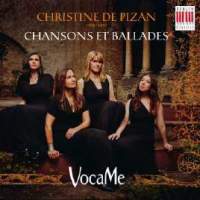Texte paru dans: / Appeared in: |
|
|
Outil de traduction ~ (Très approximatif) |
|
|
Reviewer: J.
F. Weber This collection of poems by Christine de Pizan consists of contrafacta set to melodies of Machaut, Dufay, Binchois, Bernard de Ventadorn, and others (as the notes put it), since if she ever composed any songs they have not survived. The only original song is the Binchois setting of one of her poems. The melodies of the individual contrafacta are not identified. The notes feature an autobiographical passage that begins, “I, Christine,” in which she mentions that she wrote the first tribute to Joan of Arc, in 1429; “Dite de Jehanne d’Arc” is one of the selections on the disc. As it happens, I just finished reading Joan of Arc—A History by Helen Castor (Harper, 2015), which is actually a history of the Hundred Years’ War from 1409 to 1456. Joan’s part in the course of events becomes just part of the story, which ends after the war in the year Joan was rehabilitated. Jordi Savall devoted a book-sized package to the same subject (Fanfare 36:2). This booklet, bound in
boards of the usual CD size, is lavishly illustrated with 11 color
reproductions from contemporary illuminations on Christine’s life. The
familiar Du Fay/Binchois portraits from Le champion des dames are reproduced
three times. The ensemble of four women and their director, who accompanies
on a choice of several instruments, was heard earlier in a Hildegard of
Bingen program (Fanfare 37:2). I have reviewed half a dozen CDs assembled
from 16th-century composers’ settings of Ronsard’s poems and at least one of
Petrarca’s poems (15:2), but only one track on this disc is actually a
setting of one of Christine’s poems from the same era. So this is a more
original approach, and it sounds pretty convincing. It would be interesting
to know what specific melodies Popp has chosen for each poem, but that is
his story to tell if he chooses. | |
|
|
|
|
Cliquez l'un ou l'autre
bouton pour découvrir bien d'autres critiques de CD |
|




